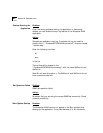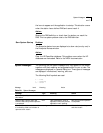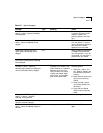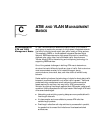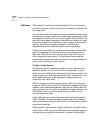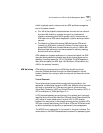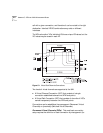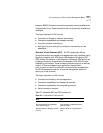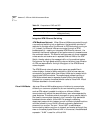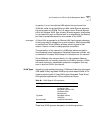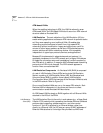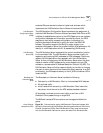
C-2 APPENDIX C: ATM AND VLAN MANAGEMENT BASICS
ATM Basics ATM uses short, fixed-length packets called cells. The first five bytes of
each cell, the header, contain the information necessary to deliver the cell
to its destination.
The fixed-length cells offer smaller and more predictable switching delays
as cell switching is less complex than variable-length packets and can be
accomplished in hardware for many cells in parallel. Having all data in the
same cell format speeds transmission dramatically by obviating the need
for protocol recognition and decoding. A good analogy is containerized
shipping, where uniform shape and weight of containers and
standardized labeling considerably ease and quicken processing.
The cell format also allows for multiprotocol transmissions. Since ATM is
protocol-transparent, the various protocols can be transferred at the
same time. With ATM, one line can carry phone, fax, video, data and
other information simultaneously. This multiprotocol advantage also
offers scalability, greatly reducing the configuration changes necessary for
adding a new traffic type to your network.
The Role of Edge Devices
All ATM traffic-handling decisions are based on the information in the
destination header, not on the content of the cell payloads. To move
traffic through the ATM network, devices at the boundary or edge of the
network convert non-ATM traffic streams into cells. The addition of new
traffic types requires only a new edge device, deployed where the
demand for such traffic exists.
ATM is a connection-oriented transport service. With only five bytes of
header, an ATM cell cannot carry the full destination address for each cell.
Instead it uses an abbreviated address, called a virtual channel identifier,
that provides enough information to establish a connection between two
ATM stations. Once a connection exists through the ATM network,
communications can ensue.
Legacy LANs employ connectionless transmission technology based on
48-bit addressing. This edge devices must have some way of adapting
existing network protocols, such as IP and IPX, to the connection-oriented
cell-switching paradigm.
ATM provides the User Network Interface (UNI) which is typically used to
interconnect an ATM user with an ATM switch that is managed as part of
the same network, as well as the Network-to-Network Interface (NNI)



